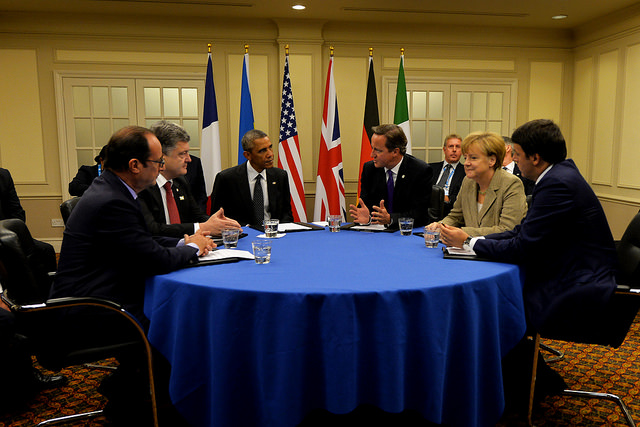 NATO just concluded its most important summit in more than a decade in Wales. Originally, the Alliance had planned to talk mostly about the way ahead in Afghanistan. But Russia’s intervention in Ukraine fundamentally changed the strategic equation. All of a sudden, NATO found itself having to reassure its east European allies about the credibility of its collective defence commitment. As well, the US and the UK added the threat posed by the Islamic State of Iraq and the Levant (ISIL) on the agenda. Finally, there was the question of what to do with NATO’s partnerships, including with Australia.
NATO just concluded its most important summit in more than a decade in Wales. Originally, the Alliance had planned to talk mostly about the way ahead in Afghanistan. But Russia’s intervention in Ukraine fundamentally changed the strategic equation. All of a sudden, NATO found itself having to reassure its east European allies about the credibility of its collective defence commitment. As well, the US and the UK added the threat posed by the Islamic State of Iraq and the Levant (ISIL) on the agenda. Finally, there was the question of what to do with NATO’s partnerships, including with Australia.
With all that on the table, and following a period of uncertainty about its post-Afghanistan future and stagnating defence budgets, expectations about a ‘new birth of NATO’ were high. In Australia, commentators expected a ‘historic partnership’ with the Alliance. One even warned about the implications of a full membership in NATO. That’s a ‘strawman’ though: Article 10 of the 1949 North Atlantic Treaty limits new membership to European countries and no one in NATO is seriously considering inviting Canberra to join. That said, in recent years Australia–NATO relations have improved significantly in the context of joint operations in Afghanistan. So, to what degree did the Wales Summit meet expectations and what are the likely implications for Australia?
As expected, Ukraine and the need to reassure eastern European allies dominated the Summit. Allies agreed on a ‘NATO Readiness Action Plan’ which includes strengthening the existing NATO Response Force (NRF) and standing up a new 4,000 strong Very-High-Readiness Joint Task Force (VJTF), headquartered in eastern Europe, for deployments ‘particularly at the periphery of NATO’s territory.’ The Summit Declaration also announced a ‘continuous air, land, and maritime presence and meaningful military activity in the eastern part of the Alliance, both on a rotational basis.’ Because this rotational presence will be more or less continuous, it’ll equal a permanent presence in all but name. While it’s not as much as some eastern European allies, notably Poland, had hoped for, it’s still a significant step for the Alliance. The rotational presence creates a ‘trip wire’ against Russian incursions in the eastern member states, particularly the Baltic republics. In that context, the allies also agreed to enhance NATO’s ability to deal with ‘hybrid warfare threats’—to counter, for example, Russian tactics observed in Georgia and Ukraine.
Still, observers were quick to criticise the Wales Summit as ‘at most a semi-success.’ That’s because allies only committed to increase defence spending to 2% of GDP within a decade. Neither did they offer Ukraine a credible path towards membership, nor decide to deploy troops in that country. Lastly, NATO also made it clear that it was largely up to individual member states to consider a military engagement against ISIL in Iraq. For critics, the Summit delivered only limited results.
Yet, it’s easy to overlook the fact that NATO today is an alliance of 28 member states with divergent strategic priorities. As I’ve written here, a key feature of such an enlarged alliance is that it’s more flexible, but also less coherent. Despite that, in Wales all members united behind the core purpose of collective defence. They agreed on concrete measures to strengthen deterrence on its Eastern flank. And the capability initiatives taken will lead to more agile and capable NATO forces. Moreover, calls for a NATO troop deployment in Ukraine or even Ukrainian membership were unrealistic from the start. For NATO, Russia is neither friend nor foe, but somewhere in between. There are no signs that Russia plans to destabilise eastern European NATO allies. That’s why NATO’s approach in Wales has been well-balanced, including leaving the door open for future dialogue with Russia.
Finally, the Summit confirmed the three core tasks set out in NATO’s 2010 Strategic Concept. Besides collective defence, the Alliance will seek to strengthen crisis management and cooperative security. In that context, NATO defence ministers met with Australia, Sweden, Finland, Georgia and Jordan to ‘discuss further deepening dialogue and practical cooperation as part of the enhanced opportunities within the Partnership Interoperability Initiative’. Australia now belongs to an upper tier of ‘Enhanced Partners’ which provides it with early access to planning in future joint operations, streamlined participation in exercises, and regular political consultations. The 2011 NATO Political Military Framework for Partner Involvement in NATO-led Operations also gives Australia an ability to ‘shape’ strategy and decisions if it decides to be part of another NATO-led operation.
The Wales Summit has paved the way for ongoing NATO–Australia cooperation beyond Afghanistan. That makes sense from an Australian perspective, especially given the Abbott government’s push to increase the country’s global security role, including in the Middle East and Ukraine. Still, even as an ‘enhanced partner’ Australia will constrain its ambition to cooperate with the Alliance to individual missions—it won’t be an automatic participant in future NATO operations. Indeed, it remains to be seen if both sides will find many more opportunities to work together in the future. That’s because Australia will have to focus on the big strategic trends in its own region whilst the European part of the Alliance will remain preoccupied with the Russian challenge for years to come. But overall, the Wales Summit has been a good outcome for both NATO and Australia.
Benjamin Schreer is a senior analyst at ASPI. Image courtesy of Flickr user NATO Summit Wales 2014.

